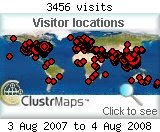Manila Standard / Michael Caber / p. A7
More than half of the world's population, or about 3.3 billion people, will be living in urban areas by 2008, according to the State of World Population Report released by the United Nations Population Fund.
"The population of towns and cities in developing countries is set to double in the space of a generation. Poor people will make up a large part of future urban growth," the agency said in a preview of the report which also noted that by 2030, urban population is expected to reach almost five billion.
As most cities struggle to meet current needs, city planners and local government officials also have to deal with the enormous scale and impact of future growth.
The report, entitled Unleashing the Potential of Urban Growth, calls for proactive actino to prepare for inevitable urbanization which can also be positive because no country in the industrial age has ever achieved significant economic growth without urbanization.
The report said cities concentrate poverty, but they also represent poor people's best hope of escaping it. Cities create environmental problems, but they can also create solutions. Concentrating population in cities can contribute to long-term sustainability.
"The bigger threat may be disordered sprawl. The potential benefits of urbanization far outweigh the disadvantages. The challenge is learning how to exploit its possibilities", the UN agency said.
For the second consecutive year, the agency also released a youth supplement, Growing Up Urban, a companion to the State of World Population 2007, which features the stories of young women and men growing up in cities of the developing world.
The report will be launched across the globe on June 27 in London and will also be launched locally on June 29 at the SGV Hall of the AIM Conference Center in Makati City.
More than half of the world's population, or about 3.3 billion people, will be living in urban areas by 2008, according to the State of World Population Report released by the United Nations Population Fund.
"The population of towns and cities in developing countries is set to double in the space of a generation. Poor people will make up a large part of future urban growth," the agency said in a preview of the report which also noted that by 2030, urban population is expected to reach almost five billion.
As most cities struggle to meet current needs, city planners and local government officials also have to deal with the enormous scale and impact of future growth.
The report, entitled Unleashing the Potential of Urban Growth, calls for proactive actino to prepare for inevitable urbanization which can also be positive because no country in the industrial age has ever achieved significant economic growth without urbanization.
The report said cities concentrate poverty, but they also represent poor people's best hope of escaping it. Cities create environmental problems, but they can also create solutions. Concentrating population in cities can contribute to long-term sustainability.
"The bigger threat may be disordered sprawl. The potential benefits of urbanization far outweigh the disadvantages. The challenge is learning how to exploit its possibilities", the UN agency said.
For the second consecutive year, the agency also released a youth supplement, Growing Up Urban, a companion to the State of World Population 2007, which features the stories of young women and men growing up in cities of the developing world.
The report will be launched across the globe on June 27 in London and will also be launched locally on June 29 at the SGV Hall of the AIM Conference Center in Makati City.













0 comments:
Post a Comment